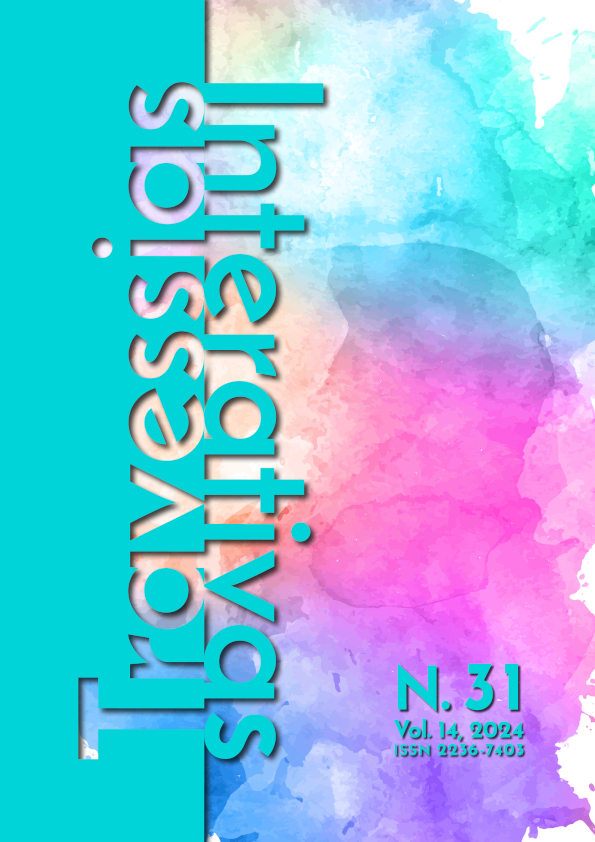Todes elus
a sociolinguistic analysis about gender-neuter marking on Twitter
DOI:
https://doi.org/10.51951/ti.v14i31.p39-55Keywords:
Gender-neuter. Gender marking. Linguistic variation. Communities of practice.Abstract
This study seeks to investigate the use of the gender-neuter in Brazilian Portuguese (the -e mark and neuter pronouns) from the theoretical-methodological perspective of the Theory of Variation (LABOV, 2008 [1972]; WEINREICH; LABOV; HERZOG, 2006 [1968]), with a focus on Communities of practice (ECKERT; MCCONNELL-GINET, 1992a, 1992b). During the second half of 2020, were collected 3,446 occurrences of pronouns, adjectives, and nouns in tweets of three subjects, users of the social network Twitter. As a selection criterion, we considered tweets containing pronouns, adjectives, and nouns whose referent was a human, in which gender distinction occurred by morphological markers. The predictor variables stipulated were participant, morphosyntactic class, lexical item, the tweet topic, and the reference performed by gender marks (generic or specific). Additionally, we aimed to control the existence or not of metalinguistic reflection in the tweets sample. The statistical treatment was conducted through the R software, through the RStudio interface. As a result, it was found that no lexical item favors the use of the neutral variant, but the morphosyntactic class of adjective, the topics of identity and affective relationship, as well as the generic reference performed by gender marking act as conditioners for the use of gender-neuter.
Downloads
References
BALDEZ, Diovana da Silveira. O uso da marcação de gênero neutro no Twitter por uma perspectiva sociolinguística. 2022. 151f. Dissertação (Mestrado em Letras/Linguística) – Pontifícia Universidade Católica do Rio Grande do Sul, Porto Alegre, Rio Grande do Sul.
BARBOSA FILHO, Fábio Ramos. Projetos de lei contrários à linguagem neutra no Brasil. In: BARBOSA FILHO, F. R.; OTHERO, G. Linguagem “neutra”: língua e gênero em debate. São Paulo: Parábola, 2022. p. 141-160.
BERNINI, Lorenzo. Macho e fêmea Deus os criou!? A sabotagem transmodernista do sistema binário sexual. Bagoas – Estudos gays: gêneros e sexualidades. Natal. v. 5, n. 6, p. 15-47, 2011.
CAMARA JR., Joaquim Mattoso. Estrutura da língua portuguesa. Petrópolis: Vozes, 1970.
ECKERT, Penelope; MCCONNELL-GINET, Sally. Communities of practice: Where language, gender and power all live. In: Locating power: Proceedings of the second Berkeley women and language conference. Berkeley, CA: Berkeley University, 1992a. p. 89-99.
ECKERT, Penelope; MCCONNELL-GINET, Sally. Think practically and look locally: Language and gender as community-based practice. Annual Review of Anthropology, Palo Alto, v. 21, p. 461-490, 1992b.
LABOV, William. Padrões Sociolinguísticos. (1972) São Paulo: Parábola Editorial, 2008.
LUCCHESI, Dante. A estrutura da língua e a criação de gênero neutro. Roseta, v. 4, n. 1, 2021.
RIO DE JANEIRO. Câmara Municipal. Projeto de Lei nº 2013/2020, de 3 de dezembro de 2020. Rio de Janeiro, 2020. Disponível em http://aplicnt.camara.rj.gov.br/APL/Legislativos/scpro1720.nsf/249cb321f17965260325775900523a42/bf0a484f271ce6950325863100652920?OpenDocument&Start=1.1.1&Count=80&ollapse=1.1.1. Acesso em 26 abril 2023.
SANTANA, Mauro Simões de. O gênero neutro: pintando o português para a luta. Diversidade e Educação, v. 9, n. 2, p. 695-710, 2021.
SCHWINDT, Luiz Carlos. Predizibilidade da marcação de gênero em substantivos no português brasileiro. In: CARVALHO, D.; BRITO, D. Gênero e língua(gem): formas e usos. Salvador: Editora da Universidade Federal da Bahia, 2020a. p. 279-294.
SCHWINDT, Luiz Carlos. Sobre gênero neutro em português brasileiro e os limites do sistema linguístico. Revista da ABRALIN, v. 19, n. 1, p. 1-23, 2020b.
WEINREICH, Uriel; LABOV, William; HERZOG, Marvin. Fundamentos empíricos para uma teoria da mudança linguística. (1968) São Paulo: Parábola, 2006.
Published
How to Cite
Issue
Section
License
Copyright (c) 2024 Travessias Interativas

This work is licensed under a Creative Commons Attribution-NonCommercial-NoDerivatives 4.0 International License.
Autores que publicam nesta revista concordam com os seguintes termos:
a) Os(as) autores(as) mantêm os direitos autorais e concedem à revista o direito de primeira publicação, sendo o trabalho simultaneamente licenciado sob a Creative Commons BY-NC-ND 4.0 International, o que permite o compartilhamento do trabalho com reconhecimento da autoria do trabalho e publicação inicial nesta revista, desde que não seja para uso comercial e sem derivações.
b) Os(as) autores(as) têm autorização para assumir contratos adicionais separadamente, para distribuição não-exclusiva da versão do trabalho publicada nesta revista (ex.: publicar em repositório institucional ou como capítulo de livro), com reconhecimento de autoria e publicação inicial nesta revista.
c) Autores têm permissão e são estimulados a publicar e distribuir seu trabalho on-line (ex.: em repositórios institucionais ou na sua página pessoal) após o processo editorial, já que isso pode gerar alterações produtivas, bem como aumentar o impacto e a citação do trabalho publicado (Veja O Efeito do Acesso Livre).
d) Os(as) autores(as) dos trabalhos aprovados autorizam a revista a, após a publicação, ceder seu conteúdo para reprodução em indexadores de conteúdo, bibliotecas virtuais e similares.
e) Os(as) autores(as) assumem que os textos submetidos à publicação são de sua criação original, responsabilizando-se inteiramente por seu conteúdo em caso de eventual impugnação por parte de terceiros.























